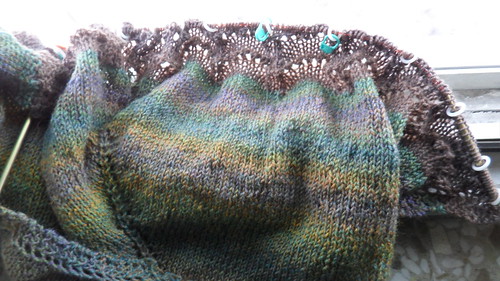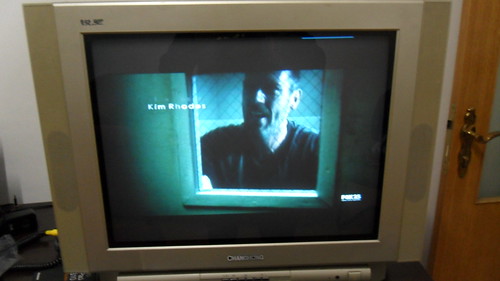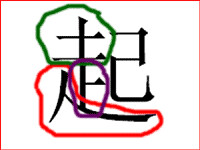A Tale of Two Characters
Read/Post Comments (0)
Well, while the majority of my North American readers (excepting my son and niece, who live in Arizona) have been springing forward, here's what's going on in this part of the world:




Despite the fact that the Spring Festival ended nearly a month ago, this isn't exactly spring-fever-inducing weather. It's darned pretty, though, and so I don't mind.
Probably I also don't mind because I can't play outside in North American fashion. As my friend Janice noted, Harbiners do play outside - just not in the ways I'd like to do. So I've been occupying my time with knitting

and catching up on old episodes of House.

(Yep, I solved my television problems with the help of a friend. I got a VGA-to-RCA-and-back-again converter . . . gonna try recording Chinese television soon. And yep, that's the dismal first episode of Season Six . . . )
I've also been studying Chinese somewhat regularly; two friends come over on Saturdays to help me learn. They've taken some books out of the library for me, and I am pleased to report that, developmentally speaking, I'm reading about as well as your average Chinese three-year-old. This might not sound very impressive (and my pleasure is regularly dampened with the realization of how much I have yet to learn), but it's very, very, very fun.
My latest triumph came the other day, when, copying out the characters from my book's second lesson, I got stuck on this one:

(That character is pronounced "chee", spelled "qi" in pinyin, and it's the second character in the word "yi qi", which means "together," which is the word I wanted to learn.)
For the life of me, I couldn't figure out how to write this one. Stroke order is incredibly important when you write Chinese characters for a variety of reasons. You're supposed to go from left to right and top to bottom, which I thought I was doing. To test myself, I try writing the characters on my iPhone's Chinese dictionary search field - the computer is incredibly dumb, and if you don't get the stroke order right, you're screwed. I must have tried 20 times to get the damn phone to understand me, to no avail. My confusion occurred partly because I didn't realize that the two horizontal lines on the left side of the character did not connect to the ones on the right side - I was drawing long lines across the whole character. (This confusion was partly caused by the typeface in the book I'm using, which is not nearly as clear as the typeface here.)
So one of my friend's grad students showed me how to write the thing. In brief:

You write the part in red first, then you write the part in green, then you write the part in purple. The very LAST part of the character to be written is the thing that looks like a backwards 5.
And then I was able to recognize that there are four parts, or as the Chinese say, radicals, in this character. (It's important to know radicals because they allegedly affect pronunciation and meaning, but you can't prove that by me, let me tell you.) Anyway, it takes a total of 11 strokes to write this character - very hard to remember 11 strokes. But 4 radicals, now, that's easy. And the only way the injunction "left to right, top to bottom" makes sense with this character is if you think about writing the entire radical in order - if you think of individual strokes, you're in a world of hurt.
So now I can not only read this character but I can write it, too.
But the totally awesome thing is: that very evening, when I walked out the door, I saw this character:

That character means "super," and it's the first character in supermarket ("chao shi"). See how it's just like qi, except instead of the backwards five there's a hoe sitting on top of a box? (The box is "kou", which is the radical for "mouth." Why it's here in this character, I have no idea. But if I ask a friend, I'll get a story about how the character came to be written the way it's written. Something else to love about Chinese characters . . . ) I just learned to speak the word for supermarket this week, but I had no idea what I was seeing when I looked at the characters over the door of the supermarket on campus. This, despite the fact that the second character, "shi," is one that I know from other contexts. (Well, the "shi" I know looks ALMOST like that one . . . )
But when I looked at that sign the other day, a light bulb went on. I knew what it was; I can read it; I can write it. Look again at qi and chao:

See the difference? If you just look at strokes, it's hard, but if you see the radicals, it's easy.
And now it seems that everywhere I look, I see characters that have the same three parts as qi and chao, with variations in the rest of the character. Frustrating thing is, I see the characters but I don't have enough Chinese vocabulary to be able to identify them with sounds yet. Ah, if only I were three years old for real . . .




Despite the fact that the Spring Festival ended nearly a month ago, this isn't exactly spring-fever-inducing weather. It's darned pretty, though, and so I don't mind.
Probably I also don't mind because I can't play outside in North American fashion. As my friend Janice noted, Harbiners do play outside - just not in the ways I'd like to do. So I've been occupying my time with knitting

and catching up on old episodes of House.

(Yep, I solved my television problems with the help of a friend. I got a VGA-to-RCA-and-back-again converter . . . gonna try recording Chinese television soon. And yep, that's the dismal first episode of Season Six . . . )
I've also been studying Chinese somewhat regularly; two friends come over on Saturdays to help me learn. They've taken some books out of the library for me, and I am pleased to report that, developmentally speaking, I'm reading about as well as your average Chinese three-year-old. This might not sound very impressive (and my pleasure is regularly dampened with the realization of how much I have yet to learn), but it's very, very, very fun.
My latest triumph came the other day, when, copying out the characters from my book's second lesson, I got stuck on this one:

(That character is pronounced "chee", spelled "qi" in pinyin, and it's the second character in the word "yi qi", which means "together," which is the word I wanted to learn.)
For the life of me, I couldn't figure out how to write this one. Stroke order is incredibly important when you write Chinese characters for a variety of reasons. You're supposed to go from left to right and top to bottom, which I thought I was doing. To test myself, I try writing the characters on my iPhone's Chinese dictionary search field - the computer is incredibly dumb, and if you don't get the stroke order right, you're screwed. I must have tried 20 times to get the damn phone to understand me, to no avail. My confusion occurred partly because I didn't realize that the two horizontal lines on the left side of the character did not connect to the ones on the right side - I was drawing long lines across the whole character. (This confusion was partly caused by the typeface in the book I'm using, which is not nearly as clear as the typeface here.)
So one of my friend's grad students showed me how to write the thing. In brief:

You write the part in red first, then you write the part in green, then you write the part in purple. The very LAST part of the character to be written is the thing that looks like a backwards 5.
And then I was able to recognize that there are four parts, or as the Chinese say, radicals, in this character. (It's important to know radicals because they allegedly affect pronunciation and meaning, but you can't prove that by me, let me tell you.) Anyway, it takes a total of 11 strokes to write this character - very hard to remember 11 strokes. But 4 radicals, now, that's easy. And the only way the injunction "left to right, top to bottom" makes sense with this character is if you think about writing the entire radical in order - if you think of individual strokes, you're in a world of hurt.
So now I can not only read this character but I can write it, too.
But the totally awesome thing is: that very evening, when I walked out the door, I saw this character:

That character means "super," and it's the first character in supermarket ("chao shi"). See how it's just like qi, except instead of the backwards five there's a hoe sitting on top of a box? (The box is "kou", which is the radical for "mouth." Why it's here in this character, I have no idea. But if I ask a friend, I'll get a story about how the character came to be written the way it's written. Something else to love about Chinese characters . . . ) I just learned to speak the word for supermarket this week, but I had no idea what I was seeing when I looked at the characters over the door of the supermarket on campus. This, despite the fact that the second character, "shi," is one that I know from other contexts. (Well, the "shi" I know looks ALMOST like that one . . . )
But when I looked at that sign the other day, a light bulb went on. I knew what it was; I can read it; I can write it. Look again at qi and chao:

See the difference? If you just look at strokes, it's hard, but if you see the radicals, it's easy.
And now it seems that everywhere I look, I see characters that have the same three parts as qi and chao, with variations in the rest of the character. Frustrating thing is, I see the characters but I don't have enough Chinese vocabulary to be able to identify them with sounds yet. Ah, if only I were three years old for real . . .
Read/Post Comments (0)
Previous Entry :: Next Entry
Back to Top